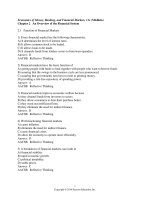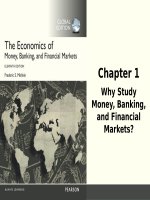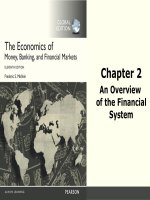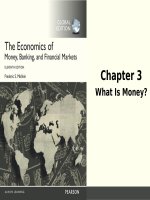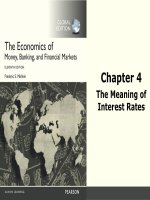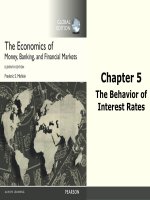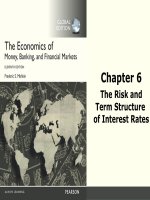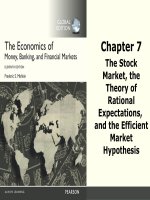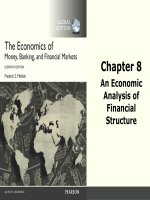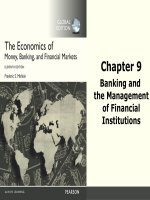The economics of money, banking, and financial institutions (11th edition) by f s mishkin ch5 the behavior of interest rates
Bạn đang xem bản rút gọn của tài liệu. Xem và tải ngay bản đầy đủ của tài liệu tại đây (971.47 KB, 33 trang )
Chapter 5
The Behavior of
Interest Rates
20-1
© 2016 Pearson Education Ltd. All rights reserved.
Preview
• In this chapter, we examine how the overall
level of nominal interest rates is determined
and which factors influence their behavior.
1-2
© 2016 Pearson Education Ltd. All rights reserved.
Learning Objectives
• Identify the factors that affect the demand
for assets.
• Draw the demand and supply curves for the
bond market, and identify the equilibrium
interest rate.
• List and describe the factors that affect the
equilibrium interest rate in the bond market.
1-3
© 2016 Pearson Education Ltd. All rights reserved.
Learning Objectives
• Describe the connection between the bond
market and the money market through the
liquidity preference framework.
• List and describe the factors that affect the
money market and the equilibrium interest
rate.
• Identify and illustrate the effects on the
interest rate of changes in money growth
over time.
1-4
© 2016 Pearson Education Ltd. All rights reserved.
Determinants of Asset Demand
• Wealth: the total resources owned by the
individual, including all assets
• Expected Return: the return expected over the
next period on one asset relative to alternative
assets
• Risk: the degree of uncertainty associated with the
return on one asset relative to alternative assets
• Liquidity: the ease and speed with which an asset
can be turned into cash relative to alternative
assets
1-5
© 2016 Pearson Education Ltd. All rights reserved.
Theory of Portfolio Choice
Holding all other factors constant:
1. The quantity demanded of an asset is positively
related to wealth
2. The quantity demanded of an asset is positively
related to its expected return relative to
alternative assets
3. The quantity demanded of an asset is negatively
related to the risk of its returns relative to
alternative assets
4. The quantity demanded of an asset is positively
related to its liquidity relative to alternative assets
1-6
© 2016 Pearson Education Ltd. All rights reserved.
Theory of Portfolio Choice
1-7
© 2016 Pearson Education Ltd. All rights reserved.
Supply and Demand in the Bond
Market
• At lower prices (higher interest rates),
ceteris paribus, the quantity demanded of
bonds is higher: an inverse relationship
• At lower prices (higher interest rates),
ceteris paribus, the quantity supplied of
bonds is lower: a positive relationship
1-8
© 2016 Pearson Education Ltd. All rights reserved.
Figure 1 Supply and Demand for
Bonds
Price of Bonds, P ($)
1,000
(i = 0%)
950
(i = 5.3%)
Bs
With excess supply, the
bond price falls to P *
A
I
900
(i = 11.1%)
B
H
C
P * = 850
(i * = 17.6%)
800
(i = 25.0%)
750
(i = 33.0%)
D
G
F
With excess demand, the
bond price rises to P *
E
Bd
100
200
300
400
Quantity of Bonds, B
($ billions)
1-9
© 2016 Pearson Education Ltd. All rights reserved.
500
Market Equilibrium
• Occurs when the amount that people are
willing to buy (demand) equals the amount
that people are willing to sell (supply) at a
given price
• Bd = Bs defines the equilibrium (or market
clearing) price and interest rate.
• When Bd > Bs , there is excess demand,
price will rise and interest rate will fall
• When Bd < Bs , there is excess supply, price
will fall and interest rate will rise
1-10
© 2016 Pearson Education Ltd. All rights reserved.
Changes in Equilibrium Interest
Rates
• Shifts in the demand for bonds:
– Wealth: in an expansion with growing wealth, the demand
curve for bonds shifts to the right
– Expected interest rates: higher expected interest rates in
the future lower the expected return for long-term bonds,
shifting the demand curve to the left
– Expected Inflation: an increase in the expected rate of
inflations lowers the expected return for bonds, causing
the demand curve to shift to the left
– Risk: an increase in the riskiness of bonds causes the
demand curve to shift to the left
– Liquidity: increased liquidity of bonds results in the
demand curve shifting right
1-11
© 2016 Pearson Education Ltd. All rights reserved.
Figure 2 Shift in the Demand Curve
for Bonds
Price of Bonds, P
A′
An increase in the demand for
bonds shifts the bond demand
curve rightward.
A
B′
B
C′
C
D′
D
E′
E
B
Quantity of Bonds, B
1-12
© 2016 Pearson Education Ltd. All rights reserved.
d
1
B2d
Shifts in the Demand for Bonds
1-13
© 2016 Pearson Education Ltd. All rights reserved.
Shifts in the Supply of Bonds
• Shifts in the supply for bonds:
– Expected profitability of investment
opportunities: in an expansion, the supply curve
shifts to the right
– Expected inflation: an increase in expected
inflation shifts the supply curve for bonds to the
right
– Government budget: increased budget deficits
shift the supply curve to the right
1-14
© 2016 Pearson Education Ltd. All rights reserved.
Shifts in the Supply of Bonds
1-15
© 2016 Pearson Education Ltd. All rights reserved.
Figure 3 Shift in the Supply Curve
for Bonds
Price of Bonds, P
B2s
B s1
I
I′
H
H′
C
C′
G
G′
F
F′
Quantity of Bonds, B
1-16
© 2016 Pearson Education Ltd. All rights reserved.
An increase in the supply of
bonds shifts the bond supply
curve rightward.
Figure 4 Response to a Change in
Expected Inflation
Price of Bonds, P
B1s
B2s
Step 1. A rise in expected inflation shifts
the bond demand curve leftward . . .
1
Step 2. and shifts the bond supply curve
rightward . . .
P1
Step 3. causing the price of bonds to fall
and the equilibrium interest rate to rise.
2
P2
d
2
B
Quantity of Bonds, B
1-17
© 2016 Pearson Education Ltd. All rights reserved.
B1d
Figure 5 Expected Inflation and Interest Rates
(Three-Month Treasury Bills), 1953–2014
Sources: Federal Reserve Bank of St. Louis FRE D database: Expected inflation calculated using
procedures outlined in Frederic S. Mishkin, “The Real Interest Rate: An Empirical Investigation,” Carnegie-Rochester Conference
Series on Public Policy 15 (1981): 151–200. These procedures involve estimating expected inflation as a function of past interest
rates, inflation, and time trends.
1-18
© 2016 Pearson Education Ltd. All rights reserved.
Figure 6 Response to a Business
Cycle Expansion
Price of Bonds, P
B1s
B2s
Step 1. A business cycle expansion
shifts the bond supply curve
rightward . . .
Step 2. and shifts the bond demand
curve rightward, but by a lesser
amount . . .
1
P1
Step 3. so the price of bonds falls
and the equilibrium interest rate
rises.
2
P2
d
1
B
Quantity of Bonds, B
1-19
© 2016 Pearson Education Ltd. All rights reserved.
B2d
Figure 7 Business Cycle and Interest Rates
(Three-Month Treasury Bills), 1951–2014
Source: Federal Reserve Bank of St. Louis FRE D database: />
1-20
© 2016 Pearson Education Ltd. All rights reserved.
Supply and Demand in the Market for
Money: The Liquidity Preference Framework
1-21
© 2016 Pearson Education Ltd. All rights reserved.
Figure 8 Equilibrium in the Market for Money
Interest Rate, i
(%)
30
25
Ms
A
With excess supply, the interest
rate falls to i *.
B
20
C
i * =15
D
10
E
5
Md
0
100
200
300
400
500
With excess demand,
the interest rate rises
to i *.
600
Quantity of Money, M
($ billions)
1-22
© 2016 Pearson Education Ltd. All rights reserved.
Supply and Demand in the Market for
Money: The Liquidity Preference Framework
• Demand for money in the liquidity
preference framework:
– As the interest rate increases:
• The opportunity cost of holding money increases…
• The relative expected return of money decreases…
– …and therefore the quantity demanded of
money decreases.
1-23
© 2016 Pearson Education Ltd. All rights reserved.
Changes in Equilibrium Interest Rates in
the Liquidity Preference Framework
• Shifts in the demand for money:
– Income Effect: a higher level of income causes
the demand for money at each interest rate to
increase and the demand curve to shift to the
right
– Price-Level Effect: a rise in the price level
causes the demand for money at each interest
rate to increase and the demand curve to shift to
the right
1-24
© 2016 Pearson Education Ltd. All rights reserved.
Changes in Equilibrium Interest Rates in
the Liquidity Preference Framework
• Shifts in the supply of money:
– Assume that the supply of money is controlled
by the central bank.
– An increase in the money supply engineered by
the Federal Reserve will shift the supply curve
for money to the right.
1-25
© 2016 Pearson Education Ltd. All rights reserved.
